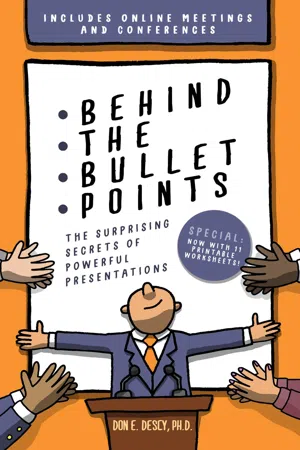
Behind The Bullet Points
The Surprising Secrets of Powerful Presentations
- English
- ePUB (mobile friendly)
- Available on iOS & Android
About this book
Don Descy hated public speaking. It terrified him. But now, over 20 years later, he has given over 500 in-person and virtual presentations, meetings and keynotes around the world and loves it! Join him as he lets you in on all of the biggest secrets (really there are only two) of public speaking including the most extraordinary of all... how to enjoy it! Follow Don as he shares his insights as he takes you from novice to pro. You will learn to:
*Overcome stage fright
*Motivate and inspire audiences
*Scout rooms and analyze audiences
*Design unforgettable visuals
*Connect with you audience and feel great
Everything you need to know is in this book!
Plus! This edition contains 11 bonus printable worksheets to help you through all aspects of presenting from your initial ideas through your final evaluation after everything is over.
Frequently asked questions
- Essential is ideal for learners and professionals who enjoy exploring a wide range of subjects. Access the Essential Library with 800,000+ trusted titles and best-sellers across business, personal growth, and the humanities. Includes unlimited reading time and Standard Read Aloud voice.
- Complete: Perfect for advanced learners and researchers needing full, unrestricted access. Unlock 1.4M+ books across hundreds of subjects, including academic and specialized titles. The Complete Plan also includes advanced features like Premium Read Aloud and Research Assistant.
Please note we cannot support devices running on iOS 13 and Android 7 or earlier. Learn more about using the app.
Information
So you have to give a presentation
Let’s talk about you
You are an actor on a stage
“Football is what I do and not who I am.” Ben Roethlisberger, Pittsburgh Steelers, 2017.
Just being an actor is not enough
“The director is the person who sets the tone of the movie and interprets the script as he sees it… He instructs the actors on how to say their lines, their facial expressions and tone. Virtually anything that happens on a movie set is subject to the approval of the director.” (Lee, 2006).
Do you see a potential problem here?
“Design works not because people understand or even appreciate it but because it works subliminally. Just like background music in a store. Nobody would admit to being influenced by it, but it generates a mood, whether we listen consciously or not.” (Medium, 2015).
Table of contents
- Title Page
- Copyright
- Contents
- Dedication
- Foreword
- 1. So you have to give a presentation
- 2. Let’s talk about you
- 3. First they have to trust you
- 4. Know your audience
- 5. Designing your presentation
- 6. Presentation graphics: What Microsoft PowerPoint designers do not understand and how to fix that
- 7. Showpersonship
- 8. Showpersonship: Questioning techniques
- 9. Showpersonship: Reducing anxiety
- 10. The big day!
- 11. Virtual meetings, videoconferencing, and webinars
- 12. You are at the finish line
- References Cited
- Other Useful Websites
- Appendix I
- Appendix II